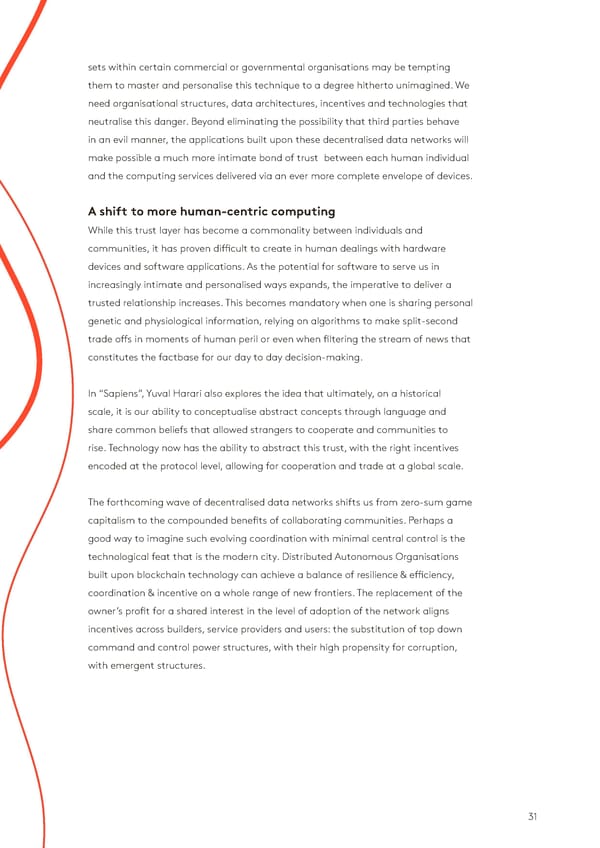A Generational Platform Shiftsets within certain commercial or governmental organisations may be tempting History them to master and personalise this technique to a degree hitherto unimagined. We We are at the start of a paradigm shift in software architecture: the wave of need organisational structures, data architectures, incentives and technologies that decentralised data networks. The movement we have seen build up over the past few neutralise this danger. Beyond eliminating the possibility that third parties behave years goes beyond Bitcoin and other crypto-assets, or even open source software and in an evil manner, the applications built upon these decentralised data networks will blockchains. Taking a broader view, it is the victory of peer-to-peer data networks based make possible a much more intimate bond of trust between each human individual on open standards, it reflects the power of properly aligned economic incentives, and it and the computing services delivered via an ever more complete envelope of devices. begins to harness the individual data centres in everyone’s pocket, desktop, car, living room and wrist. The movement is made possible by the proliferation of access to high A shift to more human-centric computing speed wireless broadband, rapidly maturing cloud-native software and a surge of recent While this trust layer has become a commonality between individuals and machine learning advancements.communities, it has proven difficult to create in human dealings with hardware devices and software applications. As the potential for software to serve us in Over the past few decades, technology architecture advancements have commoditised increasingly intimate and personalised ways expands, the imperative to deliver a operating systems and software packages by making them globally accessible via data trusted relationship increases. This becomes mandatory when one is sharing personal centres and cloud infrastructure. In this new wave, the data centre is being spread to genetic and physiological information, relying on algorithms to make split-second the very edge of the network and the data itself is being ‘open-sourced’, commoditised trade offs in moments of human peril or even when filtering the stream of news that into reusable trusted building blocks. Distributed users and machines interact with constitutes the factbase for our day to day decision-making. this data via a substrate of peer-to-peer networks. These peer-to-peer data networks become a ‘fabric’ that validates and curates information inputs without the need for In “Sapiens”, Yuval Harari also explores the idea that ultimately, on a historical third parties, while empowering individual users with their own data in a usable, secure scale, it is our ability to conceptualise abstract concepts through language and and scalable manner. share common beliefs that allowed strangers to cooperate and communities to rise. Technology now has the ability to abstract this trust, with the right incentives The Sovereign Individual encoded at the protocol level, allowing for cooperation and trade at a global scale. By empowering users with their own data, the decentralised data networks wave is breaking down the colossal data silos that have been the lifeblood, but increasingly the The forthcoming wave of decentralised data networks shifts us from zero-sum game untenable liability of today’s tech giants. Driven by central leaks such as Equifax’s data capitalism to the compounded benefits of collaborating communities. Perhaps a breach that cost 145m Americans their privacy or Facebook’s revelation that Cambridge good way to imagine such evolving coordination with minimal central control is the Analytica used personal data from 87m accounts and recently a further 50m logins technological feat that is the modern city. Distributed Autonomous Organisations were compromised, users are becoming weary of entrusting their personal data to built upon blockchain technology can achieve a balance of resilience & efficiency, 1 these centralised silos. While Google quietly discarded its “Don’t be evil” motto , here coordination & incentive on a whole range of new frontiers. The replacement of the at Fabric Ventures, we are much more interested in a new software architecture, where owner’s profit for a shared interest in the level of adoption of the network aligns 2 the motto becomes “Can’t be evil” : an architecture, in which all users control their data incentives across builders, service providers and users: the substitution of top down locally, therefore enabling the rise of the sovereign individual. As Yuval Harari posited at command and control power structures, with their high propensity for corruption, 3 a recent TED conference , totalitarianism is not the ugly force that is often depicted in with emergent structures. retrospect; instead, it presents itself as a seductively simple solution to the problems of the day that can seem foolish to resist. Harari argued that the concentration of data- 1 https://www.fastcompany.com/3056389/why-google-was-smart-to-drop-its-dont-be-evil-motto 2 https://medium.com/@muneeb/cant-be-evil-bc5ec16c6306 3 https://www.ted.com/talks/yuval_noah_harari_why_fascism_is_so_tempting_and_how_your_data_could_power_it?language=en 30 31
 State of the Token Market Page 30 Page 32
State of the Token Market Page 30 Page 32